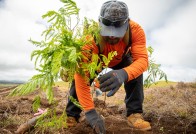Hawaiian koa (Acacia koa) has long been a revered natural resource within Hawaiian culture. Koa (which translates to “warrior” in the Hawaiian language) grows exclusively on the Hawaiian Islands and has been used for centuries for everything from canoes to furniture to art. It also enjoys special cachet among lovers of ukuleles and guitars. Koa’s seductive aesthetic beauty, with its rich colors, grain patterns and in some cases, lustrous figure, together with its distinctive tone profile, have made it a favorite among Taylor’s portfolio of guitar tonewoods for several decades.
Threats to Hawaii’s Native Forests
Over the past two centuries years, Hawaii’s native forests have gradually diminished due to a range of factors — land conversion to ranches for cattle grazing, along with a transition to agriculture for large-scale sugar and pineapple production; population growth and private land development; and the introduction of non-native plant, animal, insect and micro-organic life. (As an island ecosystem, Hawaii is especially vulnerable to invasive species.)
In fact, as an island ecosystem, Hawaii’s forests have been in a state of slow decline due to invasive weed species and fire. And without proper fencing, naturally germinating young trees (including koa) are often trampled or eaten by grazing animals such as sheep and cattle.
this is a container
92 %
Lorem ipsum dolor sit amet, consectetur adipiscing elit. Pellentesque congueLorem$ 92
Lorem ipsum dolor sit amet, consectetur adipiscing elit. Pellentesque congueLorem92 K
Lorem ipsum dolor sit amet, consectetur adipiscing elit. Pellentesque congueLoremThe good news is that forest management efforts like fencing, weed management and fire breaks are increasingly being put in place to restore native Hawaiian forests.
Quote FromOver the past two centuries years, Hawaii’s native forests have gradually diminished due to a range of factors


Caption
Over the past two centuries years, Hawaii’s native forests have gradually diminished due to a range of factors — land conversion to ranches for cattle grazing, along with a transition to agriculture for large-scale sugar and pineapple production; population growth and private land development; and the introduction of non-native plant, animal, insect and micro-organic life. (As an island ecosystem, Hawaii is especially vulnerable to invasive species.)
In fact, as an island ecosystem, Hawaii’s forests have been in a state of slow decline due to invasive weed species and fire. And without proper fencing, naturally germinating young trees (including koa) are often trampled or eaten by grazing animals such as sheep and cattle.
The good news is that forest management efforts like fencing, weed management and fire breaks are increasingly being put in place to restore native Hawaiian forests.
Quote FromLorem ipsum dolor sit amet, consectetur adipiscing elit. Pellentesque congueLorem ipsum dolor sit amet, consectetur







































